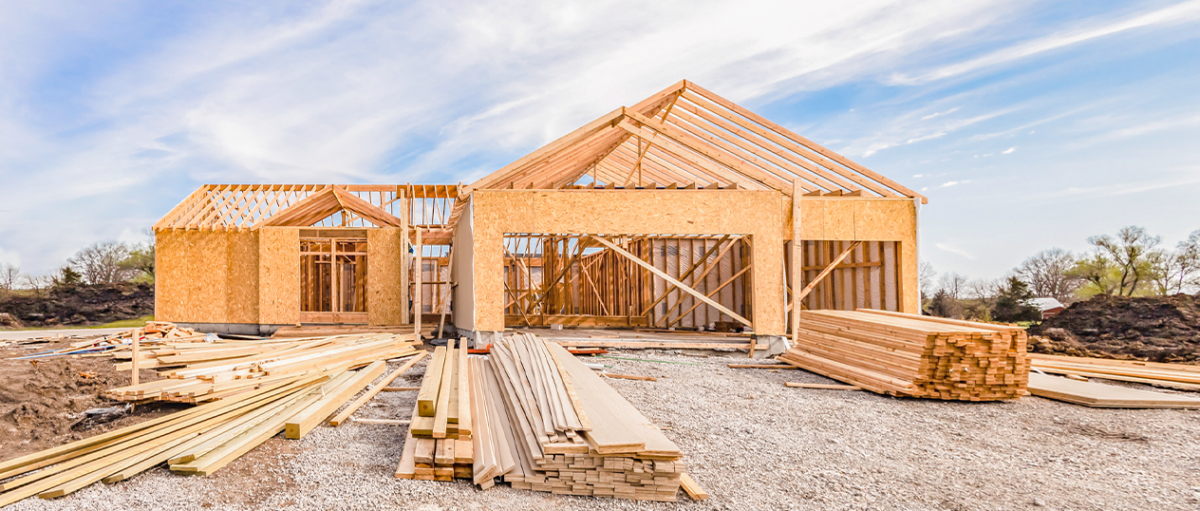Depending on market conditions, you may have trouble finding a home that checks all of your boxes. Sometimes there aren’t enough homes available in your area, sometimes there’s nothing in your budget, and sometimes you just may not like what’s out there.
If that’s the case, or if your needs have shifted throughout various life stages, you may want to consider new home construction. Not just any new construction, though—custom construction, or the opportunity to build your dream home from the ground up.
A one-time close construction loan, which allows you to pay for a plot of land, all the lumber, and the labor with one convenient mortgage, may be able to help.
Breaking down the benefits
There are three main reasons to consider a one-time close construction loan when building a custom home: Cost, credit, and closing.
Cost
Depending on what type of one-time close construction loan you go with, your down payment probably won’t be what you think it’ll be. Sure, there’s the common notion that you should put down 20% (which we’ve dispelled before), but VA buyers could obtain financing with nothing down and FHA buyers could build a custom home with as little as 3.5% down.
Beyond that, a one-time close construction loan allows buyers to roll the cost of land, building materials, and labor into one loan—saving you from having to pay two mortgages: one for the land and another for the home itself. Even better? You’ll make interest-only payments during construction, saving money upfront.
With a one-time close construction loan, you’ll make interest-only payments during construction, saving money upfront.
Credit
Because you won’t have to take out two separate loans to fund the purchase of land and labor, there’s no need to worry about re-qualifying. So, instead of taking two hits to your credit report—potentially and unnecessarily dragging down your score—you only have to submit one application and go through one underwriting process.
Closing
Since a one-time close loan pays for the land and the construction, you only have to work through one closing. That closing occurs before construction even begins, and because a one-time close loan comes with a fixed rate, you never have to worry about market changes forcing your rate to rise.
It’s all part of the process
Building a custom home isn’t as simple as buying a bunch of wood and throwing some shingles on a frame. Because a one-time close construction loan is still a mortgage, it comes with its own set of procedures and requirements. Here’s what you can look forward to:
- Contractor Validation
We’ll review your builder’s qualifications, including their own credit reports, building history, and project references. - Project Approval
If your construction details meet loan standards, we’ll make sure the budget fits the project and approve a start date. - Underwriting
After submitting your application, our underwriter will review the information like they would any mortgage. - Closing
Once approved, we’ll schedule a closing date to sign final documents and pay whatever closing costs are left to pay. - Funding
Throughout construction, your builder can request to draw funds from your loan to pay for materials, labor, and other costs. - Completion
This one’s easy! Once construction is over, it’s time to grab some friends and pack those moving boxes. - Conversion
Once everything’s done and dusted, we’ll convert your one-time close construction loan into a permanent mortgage.
Any downfalls?
One-time close construction loans are pretty straightforward, and they come with a long list of benefits (including the fact that they can be used for primary, secondary, and investment properties). That said, there are some considerations to think about before opening an application.
First, due to the COVID-19 pandemic, lead times on construction materials, as well as their costs, are both heightened in the current market. So, keep in mind: These factors could impact your total loan amount.
Second, a one-time close loan tends to come with a higher interest rate. If rates are already higher due to market conditions, you may want to run your budget with your rate quote to make sure everything is affordable.
What’s it cost?
Some sources report that building a house can cost anywhere from $500 to $1,000 per square foot, depending on location. According to American Home Shield, the average house size in the U.S. is 2,500 square feet, meaning a custom build may run anywhere from $1.25 to $2.5 million.
If that number shocked you, don’t worry too much. Other sources pin the average cost of a custom, similarly sized home at about $500,000.
So when you’re building a house, your location, equipment, and finishes can and will push your costs up or down. The safe bet is to leave some cushion in your budget, just in case. Even safer? Get pre-approved for construction loan financing with a lender you trust. That way, you know exactly what you’re getting into with your one-time close construction loan.




